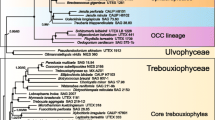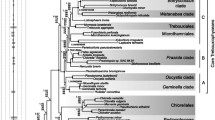Abstract
Glaucocystophyte algae (sensu Kies, Berl. Deutsch. Bot. Ges. 92, 1979) contain plastids (cyanelles) that retain the peptidoglycan wall of the putative cyanobacterial endosymbiont; this and other ultrastructural characters (e.g., unstacked thylakoids, phycobilisomes) have suggested that cyanelles are “primitive” plastids that may represent undeveloped associations between heterotrophic “host” cells (i.e., glaucocystophytes) and cyanobacteria. To test the monophyly of glaucocystophyte cyanelles and to determine their evolutionary relationship to other plastids, complete 16S ribosomal RNA sequences were determined for Cyanophora paradoxa, Glaucocystis nostochinearum, Glaucosphaera vacuolata, and Gloeochaete wittrockiana. Plastid rRNAs were analyzed with the maximum-likelihood, maximumparsimony, and neighbor joining methods. The phylogenetic analyses show that the cyanelles of C. paradoxa, G. nostochinearum, and G. wittrockiana form a distinct evolutionary lineage; these cyanelles presumably share a monophyletic origin. The rDNA sequence of G. vacuolata was positioned within the nongreen plastid lineage. This result is consistent with analyses of nuclear-encoded rRNAs that identify G. vacuolata as a rhodophyte and support its removal from the Glaucocystophyta. Results of a global search with the maximumlikelihood method suggest that cyanelles are the first divergence among all plastids; this result is consistent with a single loss of the peptidoglycan wall in plastids after the divergence of the cyanelles. User-defined tree analyses with the maximum-likelihood method indicate, however, that the position of the cyanelles is not stable within the rRNA phylogenies. Both maximumparsimony and neighbor-joining analyses showed a close evolutionary relationship between cyanelles and nongreen plastids; these phylogenetic methods were sensitive to inclusion/exclusion of the G. wittrockiana cyanelle sequence. Base compositional bias within the G. wittrockiana 16S rRNA may explain this result. Taken together the phylogenetic analyses are interpreted as supporting a near-simultaneous radiation of cyanelles and green and nongreen plastids; these organelles are all rooted within the cyanobacteria.
Similar content being viewed by others
References
Bhattacharya D, Helmchen T, Melkonian M (1995a) Molecular evolutionary analyses of nuclear-encoded small subunit ribosomal RNA identify an independent rhizopod lineage containing the Euglyphidae and the Chlorarachniophyta. J Euk Microbiol
Bhattacharya D, Helmchen T, Bibeau C, Metkonian M (1995b) Comparisons of nuclear-encoded small- subunit ribosomal RNAs reveal the evolutionary position of the Glaucocystophyta. Mol. Biol. Evol.
Bohnert HJ, Crouse EJ, Pouyet J, Mucke H, Löffelhardt W (1982) The subcellular localization of DNA components from Cyanophora paradoxa, a flagellate containing endosymbiotic cyanelles. Eur J Biochem 126:381–388
Bourrelly P (1970) Les algues d'eau douce. Tome III: Les algues bleues et rouges. Les eugleniens, peridiniens et cryptomonadiniens. N. Boubée and Cie, Paris
Cavalier-Smith T (1987) Glaucophyceae and the origin of plants. Evol Trends Plants 2:75–78
Cavalier-Smith T (1993) Kingdom protozoa and its 18 phyla. Microbiol Rev 57:953–994
Douglas SE, Turner S (1991) Molecular evidence for the origin of plastids from a cyanobacterium-like ancestor. J Mol Evol 33:267–273
Douglas SE, Murphy CA (1994) Structural, transcriptional and phylogenetic analyses of the atpB gene cluster from the plastid of Cryptomonas ϕ (Cryptophyceae). J Phycol 30:329–340
Douglas SE, Durnford DG, Morden CW (1990) Nucleotide sequence of the gene for the large subunit of ribulose-1,5-bisphosphate carboxylase/oxygenase from Cryptomonas ϕ: evidence supporting the polyphyletic origin of plastids. J Phycol 26:500–508
Douglas SE, Murphy CA, Spencer DF, Gray MW (1991) Cryptomonad algae are evolutionary chimeras of two phylogenetically distinct unicellular eukaryotes. Nature 350:148–151
Doyle JJ, Doyle JL (1990) Isolation of plant DNA from fresh tissue. Focus 12:13–15
Felsenstein J (1985) Confidence limits on phylogenies: an approach using the bootstrap. Evolution 39:783–791
Felsenstein J (1993) PHYLIP manual, version 3.5c. Department of Genetics, University of Washington, Seattle
Geitler L (1923) Der Zellbau von Glaucocystis nostochinearum und Gloeochaete wittrockiana and die Chromatophoren-Symbiosetheorie von Mereschkowski. Arch Protistenk 47:1–24
Gibbs SP (1981) The chloroplasts of some algal groups may have evolved from endosymbiotic eukaryotic algae. Ann NY Acad Sci 361:193–207
Gibbs S (1993) The evolution of algal chloroplasts. In: Lewin RA (ed) Origins of plastids. Chapman and Hall, New York, p 107
Gillott M (1990) Phylum Cryptophyta (Cryptomonads). In: Margulis L, Corliss JO, Melkonian M, Chapman DJ (eds) Handbook of protoctista. Jones and Bartlett, Boston, p 139
Giovannoni S, Turner S Olsen G, Barns S, Lane D, Pace N (1988) Evolutionary relationships among cyanobacteria and green chloroplasts. J Bacteriol 170:3584–3592
Giovannoni SJ, Wood N, Huss V (1993) Molecular phylogeny of oxygenic cells and organelles based on small-subunit ribosomal RNA sequences. In: Lewin RA (ed) Origins of plastids. Chapman and Hall, New York, p 159
Gray MW (1989) The evolutionary origins of organelles. Trends Genet 5:294–299
Greenwood AD, Griffiths HB, Santore UJ (1977) Chloroplasts and cell compartments in Cryptophyceae. Br Phycol J 12:119
Hall WT, Claus G (1963) Ultrastructural studies on the blue-green algal symbiont in Cyanophora paradoxa Korschikoff. J Cell Biol 19: 551–563
Hall WT, Claus G (1967) Ultrastructural studies on the cyanelles of Glaucocystis nostochinearum Itzigsohn. J Phycol 2:37–51
Herdman M, Stanier R (1977) The cyanelle: chloroplast or endosymbiotic procaryote? FEMS Microbiol Lett 1:7–12
Hultman T, Bergh S, Moks T, Uhlen M (1991) Bidirectional solidphase sequencing of in vitro amplified plasmid DNA. Biotechniques 10:83–84
Huson DH, Wetzel R (1994) SplitsTree, V1.0. FSP Math, Universität Bielefeld, Germany
Huss VAR, Giovannoni SJ (1992) Primary structures of the chloroplast small subunit ribosomal RNA gene from Chlorella vulgaris. Nucleic Acids Res 17:9487
Jukes TH, Cantor CR (1969) Evolution of protein molecules. In: Munro HN(ed) Mammalian protein molecules. Academic Press, New York, p 21
Kies L (1974) Elektronenmikroskopische Untersuchungen an Paulinella chromatophora Lauterborn, einer Thekamöbe mit blaugrtinen Endosymbionten (Cyanellen). Protoplasma 80:69–89
Kies L (1979) Zur systematischen Einordnung von Cyanophora paradoxa, Gloeochaete wittrockiana and Glaucocystis nostochinearum. Berl Deutsch Bot Ges 92:445–454
Kies L (1992) Glaucocystophyceae and other protists harbouring procaryotic endocytobionts. In: Reisser W (ed) Algae and symbioses: plants, animals, fungi, viruses, interactions explored. Biopress Limited, Bristol, p 354
Kies L, Kremer BP (1986) Typification of the Glaucocystophyta. Taxon 35:128–133
Kies L, Kremer BP (1990) Phylum Glaucocystopyta. In Margulis L, Corliss JO, Melkonian M, Chapman DJ (eds) Handbook of protoctista. Jones and Bartlett, Boston, p 152
Kimura M (1980) A simple method for estimating evolutionary rates of base substitution through comparative studies of sequence evolution. J Mol Evol 16:111–120
Kishino H, Hasegawa M (1989) Evaluation of the maximum likelihood estimate of the evolutionary tree topologies from DNA sequence data, and the branching order of the Hominoidea. J Mol Evol 29: 170–179
Korshikov AA (1930) Glaucosphaera vacuolata, a new member of the Glaucophyceae. Arch Protistenk 70:217–222
Leipe DD, Wainright PO, Gunderson JH, Porter D, Patterson DJ, Valois F, Himmerich S, Sogin ML (1994) The stramenopiles from a molecular perspective: 16S-like rRNA sequences from Labyrinthuloides minuta and Cafeteria roenbergensis. Phycologia 33:369–377
Lockhart PJ, Howe CJ, Bryant DA, Beanland TJ, Larkum AWD (1992) Substitutional bias confounds inference of cyanelle origins from sequence data. J Mol Evol 34:153–162
Lockhart PJ, Steel MA, Hendy MD, Penny D (1994) Recovering evolutionary trees under a more realistic model of sequence evolution. Mol Biol Evol 11:605–612
Margulis L (1981) Symbiosis in cell evolution. Freeman, Chicago
Martin W, Somerville CC, Loiseaux-de Goer S (1992) Molecular phylogenies of plastid origins and algal evolution. J Mol Evol 35:385–404
McCracken DA, Nadavukaren MJ, Cain JR (1980) A biochemical and ultrastructural evaluation of the taxonomic position of Glaucosphaera vacuolata Korsh. New Phytol 86:39–44
McFadden GI, Melkonian M (1986) Use of Hepes buffer for microalgal culture media and fixation for electron microscopy. Phycologia 25:551–557
McFadden GI, Gilson PR, Hill DRA (1994) Goniomonas: rRNA sequences indicate that this phagotrophic flagellate is a close relative of the host component of cryptomonads. Ent J Phycol 29:29–31
Mereschkowsky C (1905) Über Natur and Ursprung der Chromatophoren im Pflanzenreiche. Biol Zentralbl 25:593–604
Mereschkowsky C (1910) Theorien der zwei Plasmaarten als Grundlage der Symbiogenesis, einer neuen Lehre der Entstehung der Organismen. Biol Zentralbl 30:278–303
Morden CW, Golden SS (1991) Sequence analysis and phylogenetic reconstruction of the genes encoding the large and small subunits of ribulose-1,5-bisphosphate carboxylase/oxygenase from the chlorophyll b-containing prokaryote Prochlorothrix hollandica. J Mol Evol 32:379–395
Morden CW, Delwiche CF, Kuhsel M, Palmer JD (1992) Gene phylogenies and the endosymbiotic origin of plastids. Biosystems 28: 75–90
Olsen GJ, Matsuda H, Hagstrom R, Overbeek R (1994) Fast DNA ml: a tool for construction of phylogenetic trees of DNA sequences using maximum likelihood. CABIOS 10:41–48
Palmer JD (1993) A genetic rainbow of plastids. Nature 364:762–763
Palenik R, Haselkorn R (1992) Multiple evolutionary origins of prochlorophytes, the chlorophyll b-containing prokaryotes. Nature 355:265–267
Pascher A (1929) Uber die Natur der blaugrünen Chromatophoren des Rhizopoden Paulinella chromatophora. Zool Anz 81:189–194
Saiki RK, Gelfand DH, Stoffel S, Scharf SJ, Higuchi R, Horn GT, Mullis KB, Erlich HA (1988) Primer-directed enzymatic amplification of DNA with a thermostable DNA polymerase. Science 239:487–491
Saitou N, Nei M (1987) The neighbor joining method: a new method for reconstructing phylogenetic trees. Mol Biol Evol 4:406–425
Sanger F, Nicklen S, Coulson AR (1977) DNA sequencing with chainterminating inhibitors. Proc Natl Acad Sci USA 74:5463–5467
Schlösser UG (1982) Sammlung von Algenkulturen. Berl Deutsch Bot Ges 95:181–276
Schlösser UG (1984) Sammlung von Algenkulturen: Additions to the collection since 1982. Berl Deutsch Bot Ges 97:465–475
Schnepf E (1966) Zur Cytologie and taxonomischen Einordnung von Glaucocystis. Arch Mikrobiol 55:149–174
Skuja H (1954) Glaucophyta. In: Melcher H, Werdermann E (eds) Syllabus der Pflanzenfamilien. Borntraeger, Berlin, p 56
Sogin ML, Elwood HJ, Gunderson JH (1986) Evolutionary diversity of eukaryotic small-subunit rRNA genes. Proc Natl Acad Sci USA 83:1383–1387
Swofford DL (1993) PAUP: phylogenetic analysis using parsimony, V3.1.1. Illinois Natural History Survey, Champaign
Valentin K, Zetsche K (1990) Nucleotide sequence of the gene for the large subunit of Rubisco from Cyanophora paradoxa: phylogenetic implications. Curr Genet 18:199–202
Whatley JM (1993) Membranes and plastid origins. In: Lewin RA (ed) Origins of plastids. Chapman & Hall, New York, p 77
Author information
Authors and Affiliations
Additional information
Correspondence to: D. Bhattacharya
Rights and permissions
About this article
Cite this article
Helmchen, T.A., Bhattacharya, D. & Melkonian, M. Analyses of ribosomal RNA sequences from glaucocystophyte cyanelles provide new insights into the evolutionary relationships of plastids. J Mol Evol 41, 203–210 (1995). https://doi.org/10.1007/BF00170674
Received:
Accepted:
Issue Date:
DOI: https://doi.org/10.1007/BF00170674




